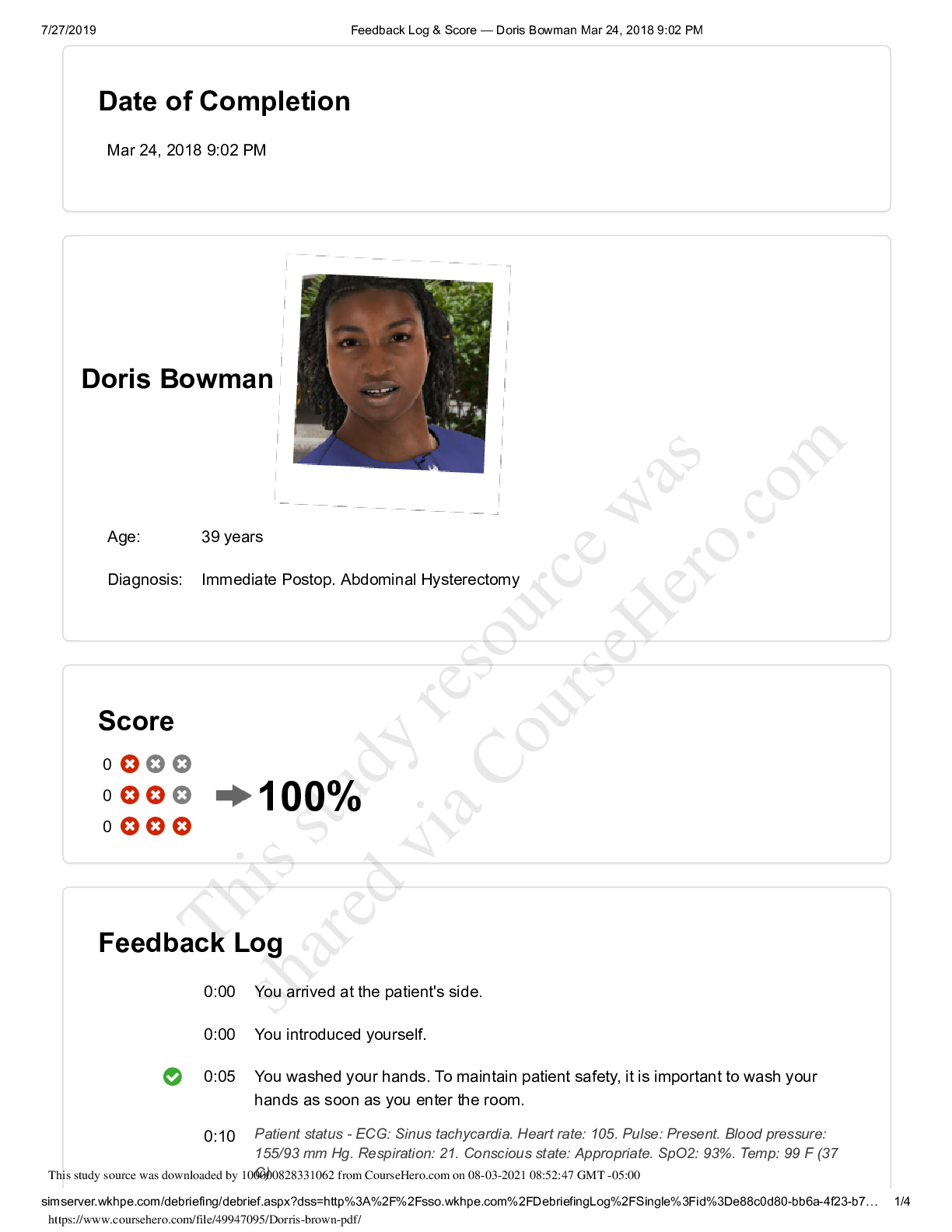*NURSING > vSim For Nursing > Vsim for nursing Post-op Abdominal Hysterectomy: Opioid Intoxication. Dorris brown. Age: 39 years Di (All)
Vsim for nursing Post-op Abdominal Hysterectomy: Opioid Intoxication. Dorris brown. Age: 39 years Diagnosis: Immediate Postop. Abdominal Hysterectomy. Feedback Log & Score — Doris Bowman. Score 100%.
Document Content and Description Below
Doris Bowman Age: 39 years Diagnosis: Immediate Postop. Abdominal Hysterectomy Score 100% Feedback Log 0:00 You arrived at the patient's side. 0:00 You introduced yourself. 0:05 You washed you... r hands. To maintain patient safety, it is important to wash your hands as soon as you enter the room. 0:10 Patient status - ECG: Sinus tachycardia. Heart rate: 105. Pulse: Present. Blood pressure: 155/93 mm Hg. Respiration: 21. Conscious state: Appropriate. SpO2: 93%. Temp: 99 F (37 1:10 Patient status - ECG: Sinus tachycardia. Heart rate: 104. Pulse: Present. Blood pressure: 149/90 mm Hg. Respiration: 21. Conscious state: Appropriate. SpO2: 94%. Temp: 99 F (37 C) 1:19 You identified the patient. To maintain patient safety, it is important that you quickly identify the patient. 1:28 You asked if the patient was allergic to anything. She replied: 'No, I am not allergic to anything.' 1:53 You attached a 3-lead ECG. It is correct to attach the monitor to the patient. 2:05 You assessed the patient's IV. The site had no redness, swelling, infiltration, bleeding, or drainage. The dressing was dry and intact. This is correct. Assessing any IVs the patient has is always important. 2:10 Patient status - ECG: Sinus tachycardia. Heart rate: 103. Pulse: Present. Blood pressure: 151/91 mm Hg. Respiration: 21. Conscious state: Appropriate. SpO2: 95%. Temp: 99 F (37 C) 2:40 You listened to the abdomen of the patient. You could hear hypoactive sounds from the abdomen. This is reasonable. 2:56 You assessed the patient's dressing. This is correct. Assessing any dressings the patient has is always important. 3:10 You looked for normal breathing. She is breathing at 21 breaths per minute. The chest is moving normally on both sides. 3:39 You attached the pulse oximeter. It is a good idea to monitor the saturation and pulse here. This will allow you to reassess the patient continuously. 3:54 You checked the radial pulse. The pulse is strong, 100 per minute and regular. It is correct to assess the patient's vital signs. 4:10 Patient status - ECG: Sinus tachycardia. Heart rate: 102. Pulse: Present. Blood pressure: 152/91 mm Hg. Respiration: 21. Conscious state: Appropriate. SpO2: 95%. Temp: 99 F (37 C) 4:21 You measured the blood pressure at 152/92 mm Hg. It is appropriate to monitor the patient by measuring the blood pressure. 4:47 You checked the temperature at the mouth. The temperature was 99 F (37 C). 4:59 You asked the patient if she had any pain. She replied: 'Yes! Ahh...' 5:05 You asked the patient if she needed anything for the pain. She replied: 'Yes. Please!' 5:10 Patient status - ECG: Sinus tachycardia. Heart rate: 102. Pulse: Present. Blood pressure: 153/92 mm Hg. Respiration: 21. Conscious state: Appropriate. SpO2: 95%. Temp: 99 F (37 C) 5:25 A 2 mg dose of morphine was injected IV. It was reasonable to give an opioid here. It is important to use the basic rights of medication administration to ensure proper drug therapy.. 5:25 The patient started developing respiratory depression. 5:37 Patient status - ECG: Sinus rhythm. Heart rate: 98. Pulse: Present. Blood pressure: 149/89 mm Hg. Respiration: 15. Conscious state: Appropriate. SpO2: 95%. Temp: 99 F (37 C) 5:47 Patient status - ECG: Sinus rhythm. Heart rate: 92. Pulse: Present. Blood pressure: 135/81 mm Hg. Respiration: 7. Conscious state: Appropriate. SpO2: 95%. Temp: 99 F (37 C) 6:06 The patient's respiration rate dropped below 6 breaths per minute. 6:09 Patient status - ECG: Sinus rhythm. Heart rate: 90. Pulse: Present. Blood pressure: 124/73 mm Hg. Respiration: 5. Conscious state: Somnolent. SpO2: 94%. Temp: 99 F (37 C) 6:15 You started assisting a patient who was breathing. You were able to provide sufficient ventilation. 6:31 You administered 0.2 mg of naloxone IV. Naloxone is the appropriate drug to give here to reverse the effect of the opioid. 6:36 You stopped ventilating the patient. 6:40 You started assisting a patient who was breathing. You were able to provide sufficient ventilation. 6:42 Patient status - ECG: Sinus rhythm. Heart rate: 89. Pulse: Present. Blood pressure: 119/69 mm Hg. Respiration: 10. Conscious state: Appropriate. SpO2: 95%. Temp: 99 F (37 C) 6:52 Patient status - ECG: Sinus rhythm. Heart rate: 90. Pulse: Present. Blood pressure: 120/69 mm Hg. Respiration: 15. Conscious state: Appropriate. SpO2: 95%. Temp: 99 F (37 C) 7:10 You stopped ventilating the patient. 7:15 You provided patient education. This is correct. It is important to use every opportunity to provide patient education. 7:19 Patient status - ECG: Sinus rhythm. Heart rate: 96. Pulse: Present. Blood pressure: 132/74 mm Hg. Respiration: 20. Conscious state: Appropriate. SpO2: 96%. Temp: 99 F (37 C) 7:38 You phoned the provider in order to discuss the patient. 8:19 Patient status - ECG: Sinus rhythm. Heart rate: 99. Pulse: Present. Blood pressure: 140/78 mm Hg. Respiration: 21. Conscious state: Appropriate. SpO2: 96%. Temp: 99 F (37 C) [Show More]
Last updated: 2 years ago
Preview 1 out of 4 pages

Buy this document to get the full access instantly
Instant Download Access after purchase
Buy NowInstant download
We Accept:

Reviews( 0 )
$11.00
Can't find what you want? Try our AI powered Search
Document information
Connected school, study & course
About the document
Uploaded On
Feb 26, 2021
Number of pages
4
Written in
Additional information
This document has been written for:
Uploaded
Feb 26, 2021
Downloads
0
Views
236







